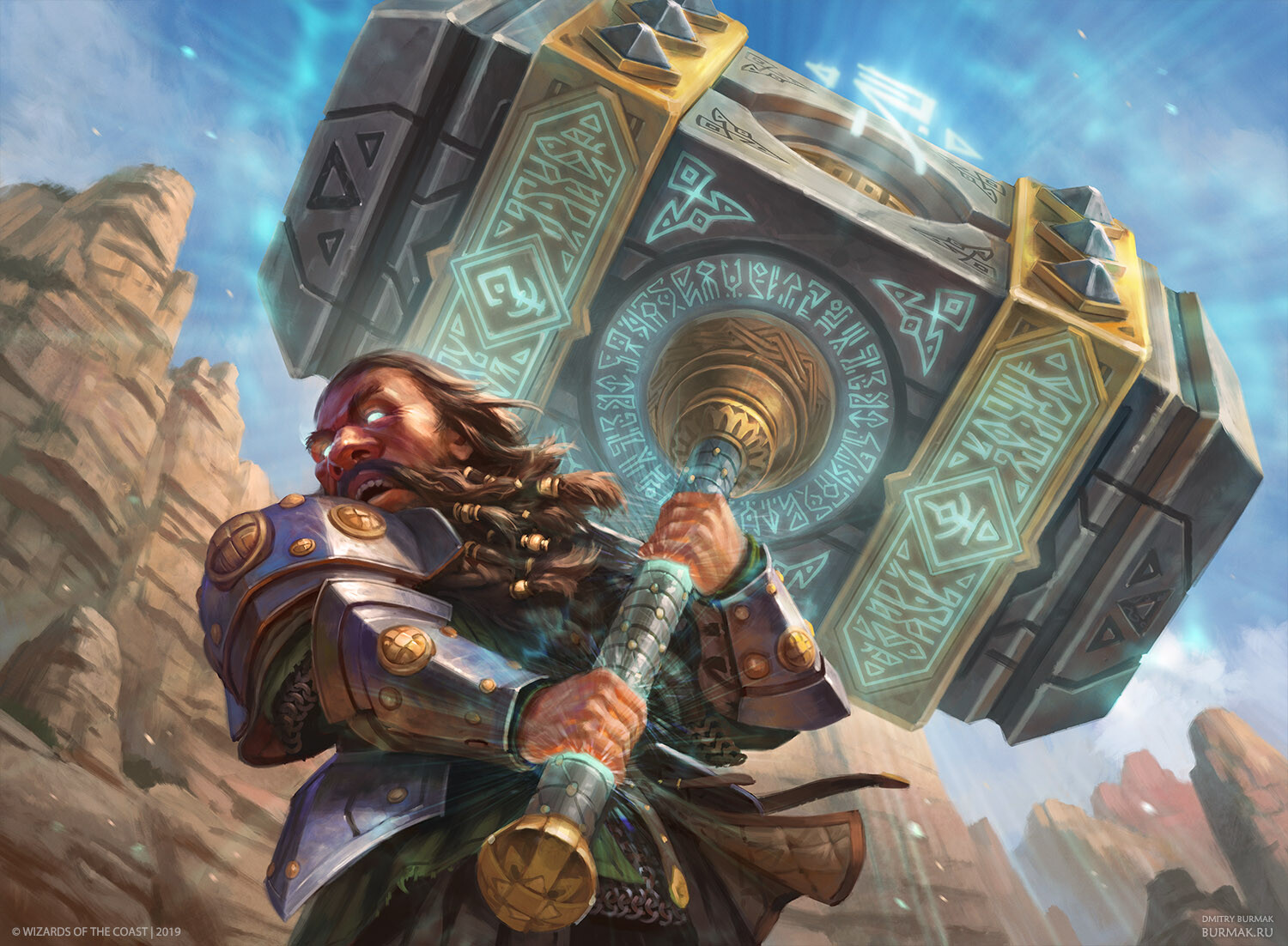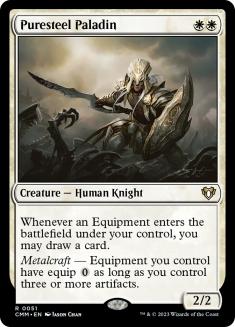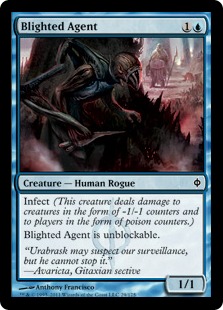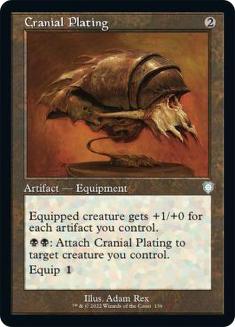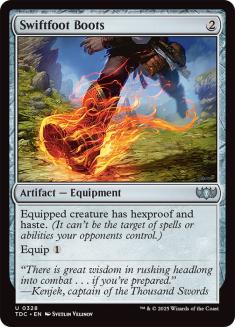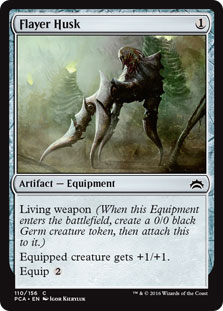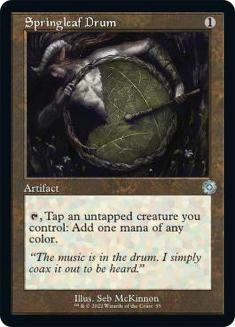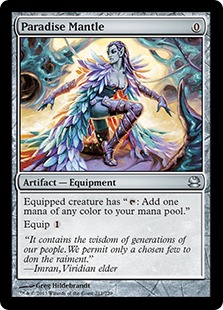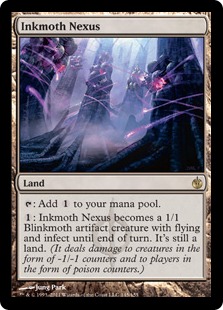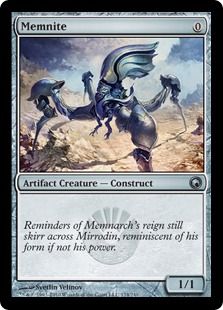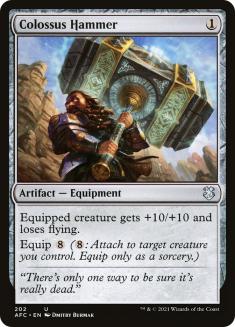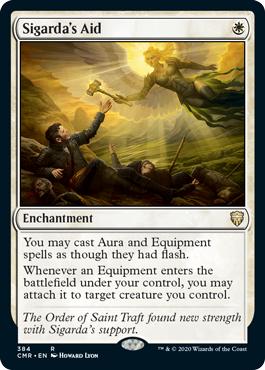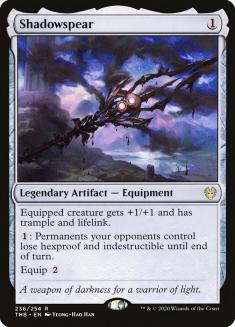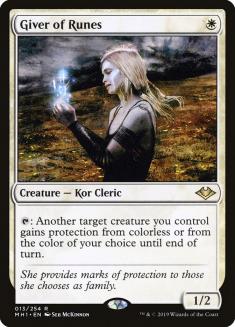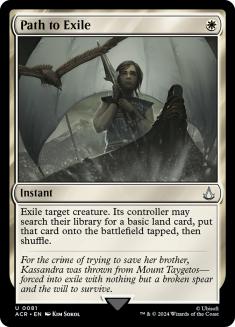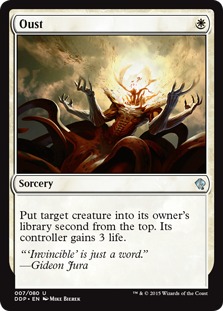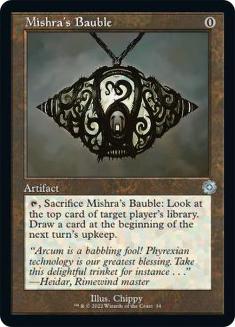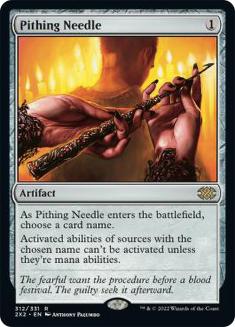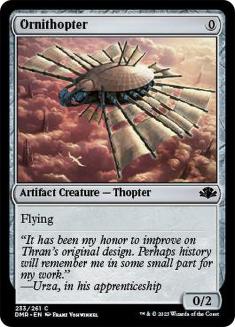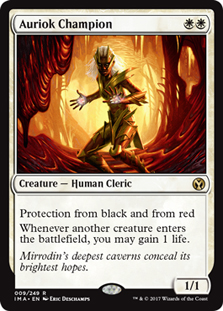When we entered post-ban Modern, I was fairly dismissive of Orzhov Hammer (Lurrus). It seemed primed for failure against an increasing number of control and midrange decks. But so far, it has kept winning. Just like with Dimir Mill (Lurrus) last week, I decided to check and see what I might be missing. And yet again, I came away quite impressed.
Is Orzhov Hammer weak against decks loaded on interaction? Absolutely, but not quite as weak as I thought it was. And it’s way better against the rest of the field than I expected. I was wrong about the deck and here is everything I learned while figuring that out.
The Philosophy of Orzhov Hammer
Orzhov Hammer is the successor to Infect for a world where Lava Dart is legal.
The difference between playing with Colossus Hammer and Glistener Elf is how binary things are with Colossus Hammer. You have the Hammer on a creature or your deck is a pile of garbage. There’s no chipping in a bit of poison and then closing out with only a few points of pump. You hit them for tens of damage or you’re extremely unlikely to win a game of Modern.
The place where Orzhov Hammer suffers relative to Infect is against removal like Abrupt Decay. Basically, any time your opponent has a card like Abrupt Decay that would be crushed by Vines of Vastwood but instead blows up Colossus Hammer, you’re going to wish you were still playing Glistener Elf. You can usually beat a single Disenchant since you have eight cards that equip things for free and effectively twelve Colossus Hammers, but once everything is an Abrupt Decay or Kolaghan’s Command, you’re unhappy.
Yea, I said it. Orzhov Hammer is a reason to play Jund. Congrats, Jundies, you got one compliment. Make it last.
Recently, some people I know were asking whether Orzhov Hammer is a hard deck to play. I think the answer is that it’s tactically punishing, where a lot of small actions can lead to widely differing outcomes, but strategically simple since you do basically the same thing over and over.
Like I said, there aren’t a lot of different end-games with Orzhov Hammer. You hit them once with an Inkmoth Nexus, you hit them twice with a random creature, or you hit them once with two Hammers. Sometimes you need to Shadowspear, or reactivate Inkmoth Nexus to give it flying, but that’s it.
So with that simplicity in mind, every game with Orzhov Hammer, you should ask the following questions:
- What do my lethal Hammer hits look like this game?
- Given my hand, when is that happening?
- What does my required mana look like for that turn, and how does that script my earlier plays?
- What can I topdeck that could accelerate my plan and can I play to make that work at no cost?
- Can I do anything about a removal spell or blocker?
That sounds like a lot, but just like there aren’t a ton of end-games for Orzhov Hammer, there aren’t a lot of unique answers to those other questions. There are the three Hammer kill patterns I mentioned. When that kill turn happens, it’s just scripting your sequencing. In terms of speeding up a kill, you can topdeck a Hammer or a Sigarda’s Aid and that’s about it. Against removal, your options are mostly “fire a second Hammer or lose.”
Basically, if you get your experience in with the deck’s basics, they’ll keep applying game after game. There aren’t buried corner-cases the way some other combo decks have. Just make a big creature and hit them. Strategically simple, with just a bit of tactical stuff to figure out.
A Well-Honed List
Creatures (19)
Lands (21)
Spells (20)
Sideboard

This list is super-clean and miles better than any of the other ones, which are bad and full of trash.
Every time you see a spare Equipment that isn’t Shadowspear, someone built their deck wrong. An undersized Cranial Plating is not fast enough to save you in a non-Hammer game. Same with this whole “find Swiftfoot Boots and cast it and equip it and then equip my Hammer and oh crap my opponent already killed me or is casting Cryptic Command” garbage. Flayer Husk is the closest to a real card since it turns Steelshaper’s Gift into something that carries a Colossus Hammer, but there’s not a good thing to cut for it.
On that topic of bad Equipment, Springleaf Drum is comically better than Paradise Mantle. It gives all your things effective haste when tapping for mana! That’s broken! If you have Turn 1 Paradise Mantle plus Memnite, you still pay one mana to enable your mana producer and you don’t get that return on Turn 1.
Let’s lay out the Turn 2 kill.
- Turn 1 Memnite, Inkmoth Nexus, tap your land for Springleaf Drum, tap Memnite and Drum for Sigarda’s Aid.
- Turn 2 play any land, activate Nexus, attack and use your Drum plus Memnite mana to Hammer them.
That just doesn’t work with Paradise Mantle. And it’s not just that dream scenario — there are many others that are just the exact same pattern. Turn 1 Springleaf Drum, Turn 2 Stoneforge Mystic and just spend your other mana. Turn 1 Springleaf Drum, Ornithopter, Steelshaper’s Gift, Turn 2 Puresteel Paladin, Hammer, smash.
On the other hand, if you have Paradise Mantle you can draw a card if you hold it until you cast Puresteel Paladin.
Very balanced options. Win the game a full turn earlier or maybe sometimes draw a card. I’m aware Magic players have problems choosing winning over drawing cards, but you’re all better than this.
Shadowspear is the one good flex Equipment because it does something. Shadowspear lets you combo-kill through blockers and it lets you race anything while attacking into chump-blockers.
Having Lurrus of the Dream-Den as your companion here is kinda weird. You will often go entire matches or even a full tournament without using it, and often the games you do get around to using Lurrus are ones you’re barely capable of winning on a good day. But it’s just so free because anything that would cost-prohibit Lurrus is something you just don’t want on a tempo basis, and barely winning is still a form of winning. If something shows up that makes you want to cut Lurrus, you can do so knowing it only really impacts your worst matchups.
The other “good enough but unexciting” card in this list is Giver of Runes. It’s a body, it forces a removal spell, and it can break through blockers, but those are all secondary to giving something +10/+10. I can see trimming one to try out a Kor Outfitter or a similar low-quality auto-equip effect.
I can see removal spells other than Fatal Push or even a mix being better. Fatal Push is by far the best option at mitigating the Death’s Shadow and Monastery Swiftspear category of threats, but it doesn’t stop things like Spike Feeder quite as well. I haven’t tried all the options yet, so I’m fine with all Pushes for now.
Mulligans, Sequencing, and Other Tips
90% of your keepable seven-card hands involve a Sigarda’s Aid or Puresteel Paladin. The other 10% involve multiple Mishra’s Baubles and a fetchland, which is known as a free mulligan, or are post-sideboard where you draw multiple copies of your sideboard card and the rest of your functional deck. Even those might be stretching. You should be more willing to keep Sigarda’s Aid, Memnite, five lands than the vast majority of hands without a free equip effect.
Why is that? Well there are eight free equip effects, while you have four Hammers plus eight ways to find it, but it’s really more a matter of speed and impact. If you have your Sigarda’s Aid or Puresteel Paladin established and draw Colossus Hammer, it costs one mana and just happens. That gives you a lot of flexibility to immediately Inkmoth Nexus someone, or be short on lands due to mulligans shorting you on cards in general and instantly win, or sacrifice a Silent Clearing to find your Hammer, or whatever.
When you do the same things when you’re searching for the equip effect, you’re less likely to have a mana-efficient turn. Sure, Sigarda’s Aid costs one mana as well, but you had to hold your Colossus Hammer to do it. Even if you draw a Puresteel Paladin, you had to hold the Hammer in case the equip effect you drew was Sigarda’s Aid.
Your Sigarda’s Aid and Puresteel Paladin hands just lead to faster, more reliable, lower-resource game wins than the hands without them and that’s all this deck wants.
I’m unsure my mulligan strategy changes much at six cards, though I could be convinced to keep Bauble hands with everything but the equip effect. At five, you start getting into “good enough” territory.
Look back at the Turn 2 kill again. It follows a lot of the good patterns from your other draws. Maximizing Springleaf Drum mana over multiple turns, landing Inkmoth Nexus early, running out Sigarda’s Aid as quickly as possible to avoid Thoughtseize, and an instant-speed Colossus Hammer to minimize blockers.
One easy thing to mess up is that Puresteel Paladin requires metalcraft for the free equip. Actually do the math. If you have all the other pieces wrapped up with a Puresteel Paladin, make sure you don’t need to keep Mishra’s Bauble around as “do nothing, count one artifact.”
In the typical case where you’re sacrificing Mishra’s Bauble, this is both one of the best decks at getting the peek plus shuffle combo and one where maximizing that matters the most. You’re almost always looking for one specific card to put everything together, so getting multiple shots at it with an optional shuffle is huge. Just make sure that you’re using it prior to your last shuffle of the turn, and that you can get away with skipping that shuffle if you see something good. Usually you can hold off on Steelshaper’s Gift, but skipping two-mana Stoneforge Mystic is sketchy.
Inkmoth Nexus costs an effective two mana to attack with. But for one more mana, you can activate Inkmoth Nexus again after you equip Hammer to it and the newer animate effect regrants it flying. Timestamps are cool.
The cantrip trigger on Puresteel Paladin is usually a trap in this deck. It’s typically more important to control the Hammer and have metalcraft immediately upon resolving Puresteel Paladin so your first action can be equipping Hammer to another creature. This forks your opponent’s removal: if they kill the other creature in response to the equip you still have Paladin to re-equip, and if they kill the Paladin you still picked up a Hammer with something else.
Giver of Runes lets you give a creature protection from colorless. Don’t do that to something that has a Hammer on it — you will be very disappointed.
Matchup and Sideboarding Guide
Your matchups with Orzhov Hammer are pretty static. Anything that isn’t heavy on interaction is solid. Anything that is heavy on interaction is dicey.
VS Mono-Green Tron
Creatures (7)
Planeswalkers (10)
Lands (18)
Spells (25)

Killing your opponent before they get a Turn 4 is fairly critical here, since that’s the turning point where Oblivion Stone or Ugin, the Spirit Dragon can land and make the game absolutely unwinnable. Not that you usually have a choice, but Sigarda’s Aid is better in this matchup than Puresteel Paladin due to the threat of Karn, the Great Creator shutting off the actual equip ability.
Out:
In:
After sideboarding, they might have Dismember, Spatial Contortion, or Nature’s Claim, but usually those involve slowing down their clock enough to let you work around it. Pithing Needle is mainly to nab Expedition Map on Turn 1 or Turn 2 while incidentally being an artifact for metalcraft.
The matchup against the Primeval Titan decks is almost identical, but the Eldrazi Tron matchup is notably worse due to Chalice of the Void. Just remember you can use Stoneforge Mystic’s ability to still stick a Hammer against that card. And you definitely still don’t want Giver of Runes due to the Colossus Hammer falling off due to protection from colorless issue.
VS Selesnya Company
Creatures (27)
- 4 Birds of Paradise
- 4 Noble Hierarch
- 4 Knight of the Reliquary
- 3 Courser of Kruphix
- 3 Tireless Tracker
- 2 Ramunap Excavator
- 1 Arboreal Grazer
- 3 Dryad of the Ilysian Grove
- 3 Skyclave Apparition
Lands (27)
Spells (6)

Your primary concern here is what you’re exposing to Skyclave Apparition. This is one matchup where holding Sigarda’s Aid or Puresteel Paladin until your combo turn is a big upgrade. If they leave up Collected Company, they can also hit Skyclave Apparition, but you have no control over that.
Out:
In:
This is the matchup you’re playing Pithing Needle for. If you shut off Spike Feeder, they’re a pretty clunky deck forced into midrange Selesnya nonsense, finding a Skyclave Apparition, or the Walking Ballista combo. I’m not 100% on the Giver of Runes as the last cut, but you can’t cut core combo components since you’re still racing them most games.
They do pick up Path to Exile, which is annoying, but their deck is still in the light-removal category and a fine matchup.
VS Prowess, Death’s Shadow, and Burn
Creatures (16)
Lands (18)
Spells (26)

Creatures (14)
Lands (19)
Spells (27)

Creatures (12)
Lands (20)
Spells (28)
- 4 Lightning Bolt
- 4 Lava Spike
- 1 Lightning Helix
- 4 Rift Bolt
- 4 Searing Blaze
- 3 Skullcrack
- 4 Boros Charm
- 4 Skewer the Critics
Sideboard

These matchups are all extremely similar and can go either way. You’re still prioritizing aggressive hands over planning for interaction, though against Rakdos Death’s Shadow it starts to get close. A Sigarda’s Aid, double Colossus Hammer kill is a clutch way to play around Lightning Bolt, using the second flashed-in Hammer as a kind of protection spell.
Out:
In:
It’s weird to sideboard in a black card and sideboard out a black source, but Auriok Champion lets you play a bit of a longer game against all of these decks. Or extremely short if you just Hammer it up. But the games you lose are the ones where you draw a bunch of air and they answer your one or two things that do matter, and you’re cutting as much air as you can while remaining a functional deck. They all should have plans like Kozilek’s Return to kill Auriok Champion, but whatever, none of those beat a 11/11 Auriok Champion.
VS Azorius Control
Creatures (4)
Planeswalkers (6)
Lands (24)
Spells (26)

This is the only matchup where things can get a bit weird and I think is still in the close range. Your threats cost significantly less than most of their answers so they’re often stuck doing nothing, but you also aren’t great at having multiple threats in a turn to exploit that. They also have Force of Negation to hold off super-fast kills, but that leaves them low on resources. The games can just take forever and I’ve actually paid eight mana to equip Colossus Hammer. I don’t think I’ve threatened the full twenty with small chip attacks, but I’ve definitely dealt ten and put them into single Hammer bash range.
One good way to punish them sitting with open mana is just picking up Lurrus early. You still don’t get to really exploit them with a double-spell turn with Lurrus until much later, but it at least lines up better than just letting them trade their mana on the first turn they wanted to do that.
Weird one for this matchup: you can protect Inkmoth Nexus from Field of Ruin with Giver of Runes.
Out:
In:
Thoughtseize counts as a threat on your double-spell turns, which makes lining up well against expensive counterspells much easier. The dynamic doesn’t change much besides that addition, so just keep at it and you will eventually win. Or lose.
VS Jund Midrange
Creatures (7)
Planeswalkers (8)
Lands (22)
Spells (23)

The nightmare matchup. The frustrating part is that you feel like you have little agency over when you lose because they just have it, but you just randomly win enough that you always have hope. Honestly, you can say the same about many of the losses with this deck, but Jund is the most extreme spot. Maybe that’s upside, since you just have to learn to accept it the fastest.
Much more than the Azorius matchup, you want to be picking up Lurrus against open mana. There’s no point in running a threat into an open Abrupt Decay or whatever — you want your threats to potentially choke their mana up. If you let Lurrus sit until much later, it often takes too long to pick it up, cast it, and get value from it. You want your “Lurrus, recast something relevant, force double removal” turn to happen as soon as possible before you’re killed by a Tarmogoyf attack.
Out:
In:
The sideboard plan is almost identical to the plans for the Rakdos and Mono-Red decks, but I’m less certain you want all the Fatal Pushes when Wrenn and Six and Liliana of the Veil are the relevant threats. One more Ornithopter just for metalcraft and as sacrifice fodder for Liliana might be better, with Memnite being garbage that dies to Wrenn and Six.
Overall, Orzhov Hammer is a solid component of the Modern metagame. It has clear weaknesses, yet is strong enough to push through them and steal wins. So far it feels like the most reliably fast deck in the format, but not by so much it clearly outclasses the other Turn 3 to Turn 4 combo decks.
And if you’ve been missing your aggro-combo fix with the Mox Opal ban crushing Arcbound Ravager and the Lava Dart printing taking out Glistener Elf, Orzhov Hammer is probably the deck you are looking for.

